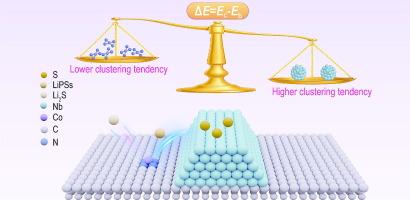Dynamic anchoring and catalysis via Co-Nb dual sites in lithium-sulfur batteries
IF 14.9
1区 化学
Q1 Energy
引用次数: 0
Abstract
Single-atom catalysts are promising for lithium-sulfur (Li-S) batteries due to their high degree of atomic utilization and strong interactions with lithium polysulfides (LiPSs). However, the limited number of active sites and their rapid saturation hinder the continuous adsorption and efficient conversion of LiPSs. Herein, we report a bimetallic catalyst comprising single cobalt atoms (CoSA) and niobium atomic clusters (NbAC) anchored on graphene-like nanosheets (CoSANbAC/NC), which are synthesized via a cohesive energy-driven selective metal aggregation strategy. This dual-site configuration forms an electronically asymmetric interface, where NbAC anchors LiPSs via Coulombic and Lewis acid-base interactions, while CoSA enables S–S bond polarization and cleavage through d-p orbital coupling. The interfacial charge redistribution and orbital coupling between Co and Nb facilitate electron transfer between catalytic sites. Therefore, the S/CoSANbAC/NC cathode maintains a high areal capacity of 6.12 mAh cm−2 after 60 cycles under a high sulfur loading of 6.2 mg cm−2. This work demonstrates a rational design strategy for high-performance Li-S cathodes via synergistic bimetallic catalysis.

锂硫电池中Co-Nb双位点的动态锚定和催化作用
单原子催化剂由于其高度的原子利用率和与多硫化锂(LiPSs)的强相互作用,在锂硫(li -硫)电池中具有广阔的应用前景。然而,有限的活性位点及其快速饱和阻碍了LiPSs的连续吸附和有效转化。本文报道了一种双金属催化剂,该催化剂由单钴原子(CoSA)和铌原子团簇(NbAC)组成,锚定在类石墨烯纳米片(CoSANbAC/NC)上,通过内聚能驱动的选择性金属聚集策略合成。这种双位点结构形成了一个电子不对称界面,其中NbAC通过库仑和刘易斯酸碱相互作用锚定lips,而CoSA通过d-p轨道耦合实现S-S键极化和裂解。Co和Nb之间的界面电荷重分配和轨道耦合促进了催化位点之间的电子转移。因此,S/CoSANbAC/NC阴极在高硫负载为6.2 mg cm - 2的情况下,在60次循环后保持6.12 mAh cm - 2的高面积容量。本研究展示了一种通过协同双金属催化制备高性能锂离子电池阴极的合理设计策略。
本文章由计算机程序翻译,如有差异,请以英文原文为准。
求助全文
约1分钟内获得全文
求助全文
来源期刊

Journal of Energy Chemistry
CHEMISTRY, APPLIED-CHEMISTRY, PHYSICAL
CiteScore
19.10
自引率
8.40%
发文量
3631
审稿时长
15 days
期刊介绍:
The Journal of Energy Chemistry, the official publication of Science Press and the Dalian Institute of Chemical Physics, Chinese Academy of Sciences, serves as a platform for reporting creative research and innovative applications in energy chemistry. It mainly reports on creative researches and innovative applications of chemical conversions of fossil energy, carbon dioxide, electrochemical energy and hydrogen energy, as well as the conversions of biomass and solar energy related with chemical issues to promote academic exchanges in the field of energy chemistry and to accelerate the exploration, research and development of energy science and technologies.
This journal focuses on original research papers covering various topics within energy chemistry worldwide, including:
Optimized utilization of fossil energy
Hydrogen energy
Conversion and storage of electrochemical energy
Capture, storage, and chemical conversion of carbon dioxide
Materials and nanotechnologies for energy conversion and storage
Chemistry in biomass conversion
Chemistry in the utilization of solar energy
 求助内容:
求助内容: 应助结果提醒方式:
应助结果提醒方式:


